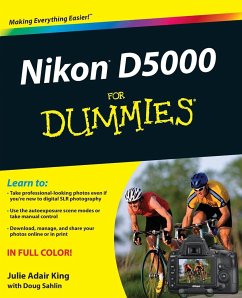
Canon EOS Rebel T2i / 550d for Dummies
Versandkostenfrei!
Versandfertig in 2-4 Wochen
30,99 €
inkl. MwSt.
Weitere Ausgaben:

PAYBACK Punkte
15 °P sammeln!
The straightforward guide to the new Canon EOS Rebel T2i/550DPopular tech blog Gizmodo.com called the Canon EOS Rebel T2i/550D "an incredible camera - everything a first DSLR should be." With 1080p digital video capability and an 18 megapixel sensor that improves low-light shooting all for under $900, the accolades are well-earned. And for less than $30, you can learn how to maximize your digital photography experience! Packed with more than 300 color photos and 100 color screen captures throughout, this beginner book walks you through the camera's controls, features, and shooting modes. If yo...
The straightforward guide to the new Canon EOS Rebel T2i/550D
Popular tech blog Gizmodo.com called the Canon EOS Rebel T2i/550D "an incredible camera - everything a first DSLR should be." With 1080p digital video capability and an 18 megapixel sensor that improves low-light shooting all for under $900, the accolades are well-earned. And for less than $30, you can learn how to maximize your digital photography experience! Packed with more than 300 color photos and 100 color screen captures throughout, this beginner book walks you through the camera's controls, features, and shooting modes. If you're new to the Canon EOS Rebel T2i/550D, this fun and friendly guide shifts you out of automatic mode and helps you shoot memorable digital photos.
Aimed at first-time dSLR users looking for a guide that clearly and patiently explains the features and controls of the Canon EOS Rebel T2i/550D
Explores the on-board controls and situational shooting
Addresses using live view and playback modes
Explains dialing in exposure and lighting controls
Details how to edit, print, post online, and other ways to share images
Spells out how to manipulate focus and color controls
Canon EOS Rebel T2i/550D For Dummies delivers a straightforward look through the lens of your dSLR!
Popular tech blog Gizmodo.com called the Canon EOS Rebel T2i/550D "an incredible camera - everything a first DSLR should be." With 1080p digital video capability and an 18 megapixel sensor that improves low-light shooting all for under $900, the accolades are well-earned. And for less than $30, you can learn how to maximize your digital photography experience! Packed with more than 300 color photos and 100 color screen captures throughout, this beginner book walks you through the camera's controls, features, and shooting modes. If you're new to the Canon EOS Rebel T2i/550D, this fun and friendly guide shifts you out of automatic mode and helps you shoot memorable digital photos.
Aimed at first-time dSLR users looking for a guide that clearly and patiently explains the features and controls of the Canon EOS Rebel T2i/550D
Explores the on-board controls and situational shooting
Addresses using live view and playback modes
Explains dialing in exposure and lighting controls
Details how to edit, print, post online, and other ways to share images
Spells out how to manipulate focus and color controls
Canon EOS Rebel T2i/550D For Dummies delivers a straightforward look through the lens of your dSLR!














